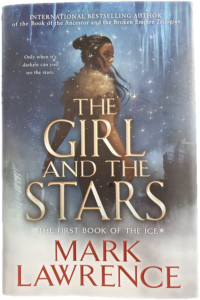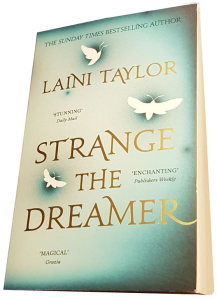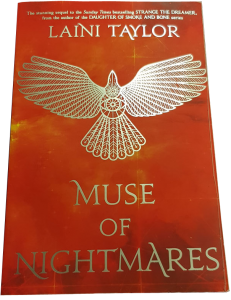Jan 25, 2021 | Reviews
I don’t often fall headlessly in love.
But with these books by Mark Lawrence, I did.
Red Sister is the first book in the trilogy called Book of the Ancestor. Mark Lawrence has previously written two fantasy trilogies in a different world — one brutal grimdark and one dark comedy. I haven’t read the grimdark one, and I didn’t much like the dark comedy, but they’re mighty popular among other people, so I guess it’s just a matter of personal taste.
Red Sister, however, created a new benchmark for my reading materials in terms of tone and style. It hit all the marks (ha!) on things I didn’t know I loved until this book showed me.
Now, Nona isn’t an entirely likeable character, but you will have to look past that. There are plenty of other likeable characters from early on. And there are mysteries wrapped in mysteries, which seems to be something of a specialty of Lawrence’s. In his first two trilogies, the setting hides a treasure trove of history. Much is wrapped in the mists of time and only hinted at in the books, outlined in broad strokes for those who know what to look for. In The Book of the Ancestor, though set in a different world, there’s perhaps even more history — most of it unknown to Nona and her friends. What little information remains from earlier civilisations is either lost to time or warped into myths that hardly anyone believes in.
In the first book, Red Sister, this is all mainly background and setting. The focus is on Nona and her life as a newcomer in a monastery of fighting nuns. But the farther you read, the more Nona has to start worrying about those age-old mysteries, because if she doesn’t, people she cares about (and who you care about, too) will die.
And then there’s the atmosphere. The world itself is dying, little by little, as the light fades from an aging star. The tone this sets is a thing of absolute beauty. Combine that with Lawrence’s skills with the English language, and the result is a masterpiece.
 I didn’t quite realise what the different parts were that made it so beautiful until I had finished the series. And when I started on The Girl and the Stars, the first book of his next trilogy, I paid closer attention. And this book didn’t just offer another visit to the world I enjoyed. No, the first part of the Book of the Ice trilogy takes everything I liked about Book of the Ancestor to the next level.
I didn’t quite realise what the different parts were that made it so beautiful until I had finished the series. And when I started on The Girl and the Stars, the first book of his next trilogy, I paid closer attention. And this book didn’t just offer another visit to the world I enjoyed. No, the first part of the Book of the Ice trilogy takes everything I liked about Book of the Ancestor to the next level.
For one, the knowledge you gained from the Book of the Ancestor trilogy lets you get one step ahead of Yaz, the main character, in her road to discovery of anything from magic powers to the world itself. There’s also the sweet little detail that Yaz is a thoroughly likeable character. The mysteries-conflicts are present — up close, in her face — from the first third or so of the book. There’s even a character, almost like an Easter egg, hinting at connections between this world and the grimdark/comedy one.
I’ve read reviews from people who thought The Girl and the Stars was too slow and that nothing happened, but they can’t have been paying proper attention. The book is a ticking bomb. I can only wait, bite my fingernails, and see what books 2 and 3 will offer.
One thing I found interesting when I heard about it is, Mark Lawrence has aphantasia, a neurological variation that means he doesn’t have a ‘mind’s eye’. I have a mild version of aphantasia myself, that makes it hard for me to picture anything more than just the broad strokes of an image. If I try to focus on a detail, the rest disappears.
Lawrence does, however, seem to share a different ability I have, to imagine the ‘feel’ or ‘sense’ of a room, a scene, an item, a person. (I can seriously imagine the ‘feel’ of a green wooden chair. Nope, not joking. But I struggle to see it clearly.) And perhaps this quirk helps Lawrence capture the feeling, the essence, of this bleak world, when others might have focused on visuals. Or perhaps it has nothing to do with it. Who knows?
But if he can write books like these, then maybe there’s hope for me, too.
So, there. I’m adding another name to my top-whatever list of Most Beloved Authors.
I would actually say he ranks among the top three, beside Robin Hobb and Laini Taylor.
My hat’s off to you, sir.
Jan 19, 2019 | Reviews
A couple of years or so ago I read a book that made me both uncomfortable and angry. I read it because so many people loved the book, the series, the author. One of the reasons I haven’t yet completely let go of my anger is that people online still pour out their love. Maybe one reader out of a hundred sees the book the same way I see it.
This anger and discomfort is the reason I’m not going to do a proper review of the book. Besides, too much time has passed and the story isn’t fresh in my mind anymore.
The book in question is The Painted Man (in the US: The Warded Man) by Peter V. Brett. It’s the first book in the Demon Cycles series.
(Spoilers follow.)
My discomfort started with how he portrayed one of the POV characters, the girl Leesha. She is one out of three protagonists. The other two are boys.
The boys are pretty well fleshed-out characters, even though none of the POV characters act rationally (I’ll come back to that later). But Leesha is strangely flat and almost incoherent.
A third of the time she acts like a stuck-up school girl who is also the teacher’s pet, a third of the time she acts like a mother figure with an ocean of patience, and the remaining third of the time she rebels against everything and everyone.
Now, I wouldn’t actually object to this type of sudden changes in a teenager’s personality, if only we saw proper reasons for them. But we don’t.
Her rebelling isn’t built up with enough frustration and pent-up anger. The incident that supposedly causes her to turn against every single person in her whole village comes across as stupid and blown out of proportion: a boy she’s had a crush on gets into her bed. They don’t have sex but he says they did. The villagers’ reaction to this lie, which they take for truth, is strange and stupid and more appropriate for a small community’s treatment of an outsider, than the judgement such a community would pass on one of their own. Blood, water, thickness, you know.
All three POV characters share these unmotivated behaviours. The older boy, Arlen, runs away from his father and his village and into demon-infested, unfamiliar woods, just because his mother died.
Okay, sure, there was a little more to it, but not enough. Any real eleven-year-old boy with any kind of self-preservation instinct would turn back and go home once the demons started showing up.
Even if his father did not rescue his dying mother from demons.
But the author needed the characters to go this way and do these things, so they did, like puppets on strings. Fantasy isn’t known for being a character-driven genre, but this is plain awful.
Still, this wasn’t what provoked the anger in me. Bad characterisation is bad, but I usually shrug and move on to something (hopefully) better.
What made me angry about this book was … well, this:
(Content warning: sexual violence.)
At the age of 26, Leesha is still a stuck-up teacher’s pet, and still a patient mother figure healing everyone because she’s such a good person. She is a virgin, too, because she’s still traumatised after that boy’s lie when she was 13. Either that, or she has ‘saved herself’ for the ‘perfect husband’. It doesn’t matter. To each, their own, and I’m not gonna judge her decisions; only the author’s awful character-building.
Anyway. When travelling back to her old home village after 13 years away, she is robbed and raped by three outlaws.
And the very next day she has consensual sex with a scary, intimidating stranger who hardly speaks with anyone, is rude whenever he does speak, is covered from head to toe in mysterious tattoos, and strangles demons with bare hands!
Now, the reader knows who the tattooed stranger is. He’s Arlen, the same boy who ran away from his father and didn’t return even though demons tried to eat him.
The reader might even like this stupid boy with no sense of self-preservation, who has now grown up to be a bad-tempered demon-strangler. Which, I assume, is the reason the author can get away with this absolutely awful scene.
But Leesha doesn’t know who Arlen is.
And more importantly, Leesha has just been raped and left to die in the woods.
Leesha must be suffering from some serious trauma after this violent first exposure to anything involving men’s private parts and their invasion of her body. Leesha should react like any rape victim and fear men, physical touch, and people in general, to the point where she starts crying every time someone or something spooks her. Which should be often.
What Leesha should definitely not do, as a violated person suffering fresh sexual trauma and probably injuries ‘down there’, is willingly have sex with a complete stranger in the same cold, wet woods where she got raped.
Most women understand this. Even those of us who are lucky enough never to have gone through this trauma usually understand it on some level.
It baffles me that there are men out there, like this Peter bloke, who don’t. That there are people out there, men and women, who love Peter’s book and have no issues with this scene.
It scares me.
Because if rape is treated like a mere slap on the butt or, at the worst, a fist to the face, people aren’t going to understand what an immense violation it actually is, how it taints your sense of self, your self-respect, your confidence, the connection between your body and your sense of self. Even your integrity and self-control.
People aren’t going to understand why consent is so very, very important.
Seriously.
No, I mean it. Seriously. If you don’t want to have to touch upon all that shit — the shame, the fear, the self-loathing, the trust issues, the flashbacks, the PTSD, the broken shards of a human soul which hide inside that violated body — then you really shouldn’t write about rape.
It’s as simple as that.
Dec 31, 2018 | Reviews
Even though this isn’t technically a blog, I have now decided to occasionally write and post book reviews here. As it happens, I’m going to start not with one, but two books in a duology I absolutely love: Strange the Dreamer and Muse of Nightmares, by Laini Taylor.
These books are the first I read from Taylor, and strangely enough (pun intended), they aren’t the books I meant to read. I was recommended Daughter of Smoke and Bone because of a character’s hair colour (I colour my hair blue). But I didn’t get around to ordering them and then, one day, in a book shop, with a gift card in my wallet, I found a different book by Laini Taylor, namely Strange the Dreamer.
The cover was absolutely lovely: light blue with little winged insects in white, title in gold, tasteful and stylish. So I bought it. Without reading the back blurb, because such is my habit when buying books or authors I’ve been recommended.
Little did I know it was the first book of two. Finishing the first book and realising I was now missing book two, I despaired for three whole days, before giving in to the craving. And so it happened that I eventually got around to sending that order: Muse of Nightmares and, finally, the trilogy I originally meant to read. (I haven’t yet, though. I don’t want to spoil myself too much. Then I’ll have nothing left to look forward to.)
When I read a series, the individual books often melt into one long tale in my mind, so that’s why I won’t review the books separately.
In Strange the Dreamer, we start off with a prologue of epic proportions, hook- and story-wise. It’s two pages long but it caught my interest like no first pages ever have. I spent the rest of the book trying to figure out what the prologue meant.
Next we get to meet Lazlo Strange, a dreamer boy, an orphan. Lazlo is who Kvothe might have been, had he been humble.
Lazlo gets to go on an adventure, where he encounters age-old secrets, mysteries, tragedies — and Sarai, a blue-skinned girl who can shape dreams.
The book is written from omniscient point of view, but because of the physical distance between the characters, we switch back and forth between Lazlo’s group of friends and Sarai’s. There’s some head-hopping occasionally, but then again, to me, most stories written in omniscient POV feel like that.
I absolutely loved both the main characters. Perhaps Lazlo is ‘unmanly’ from some men’s perspective. Perhaps women write men softer and more emotional than they are. But I still love him as a character — perhaps because I am a woman.
Sarai, however, I know is well-written. Women know how to write women. Or, at least, Taylor does. The other female characters, too, are complex and three-dimensional, even though we only occasionally get to glimpse the inside of their heads.
In Muse of Nightmares, the tale continues with the same secret/tragedy/mystery to be solved, but we also get to meet Kora and Nova, two girls in a fishing village where ice and limb-claiming cold form their daily lives. Their story gets interwoven with Sarai’s and Lazlo’s lives in a way they — and I — had not foreseen.
The second book starts off slower than the first, with almost half consisting of little more than dialogue, but when it gets going, it sure gets going!
The only thing I could wish had been done differently would be for the Kora-Nova storyline to be wrapped up better. As it is, it feels rushed, like Taylor was afraid to give the characters more time to speak.
I had not expected two young-adult novels to rise to the starry sky of My Most Beloved Books, but they did. And unless the Daughter of Smoke and Bone greatly disappoints me, Laini Taylor will rise to my list of Most Beloved Authors.
I salute you, pink-haired sister.
2021 edit:
This is a belated update, as it’s now been a long time since I read the Daughter of Smoke and Bone trilogy. I just haven’t got around to writing about it. But…
The books are an absolute delight.
This trilogy is definitely more YA than Strange the Dreamer, and the prose is more contemporary and simplistic. Perhaps not surprising, as she wrote Daughter of Smoke and Bone first. She would have grown as an author by the time she wrote the follow-up duology. Because — yes, they’re set in the same universe, of sorts. That’s all I will tell you.
And yes, she did rise to the top of that list of mine. This is beautiful storytelling that I can only wish to ever emulate.
I will also mention, to those who are thus inclined, that Laini Taylor has set up a Patreon account, and it’s so totally worth getting a window into her life and her writing.
 I didn’t quite realise what the different parts were that made it so beautiful until I had finished the series. And when I started on The Girl and the Stars, the first book of his next trilogy, I paid closer attention. And this book didn’t just offer another visit to the world I enjoyed. No, the first part of the Book of the Ice trilogy takes everything I liked about Book of the Ancestor to the next level.
I didn’t quite realise what the different parts were that made it so beautiful until I had finished the series. And when I started on The Girl and the Stars, the first book of his next trilogy, I paid closer attention. And this book didn’t just offer another visit to the world I enjoyed. No, the first part of the Book of the Ice trilogy takes everything I liked about Book of the Ancestor to the next level.


